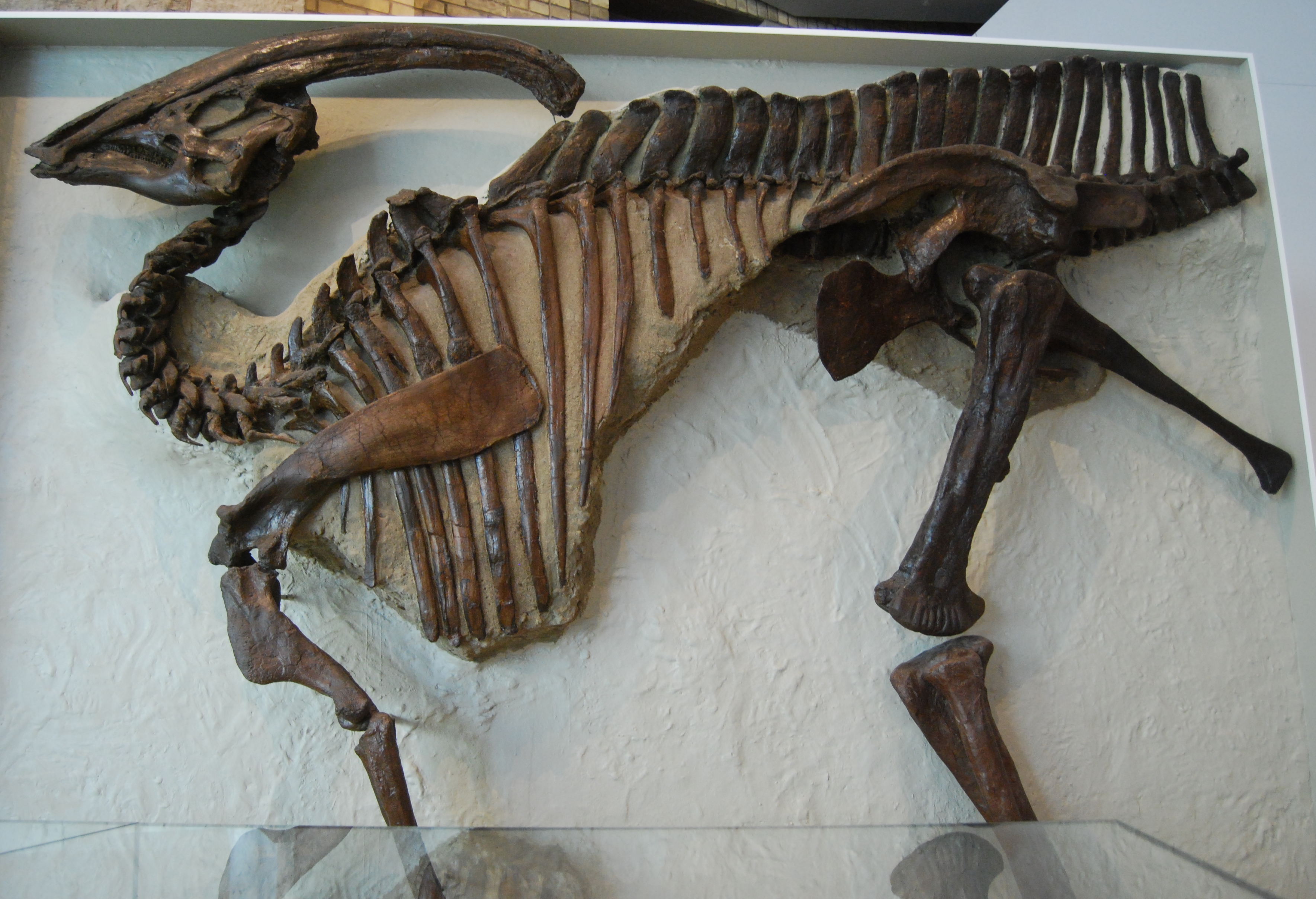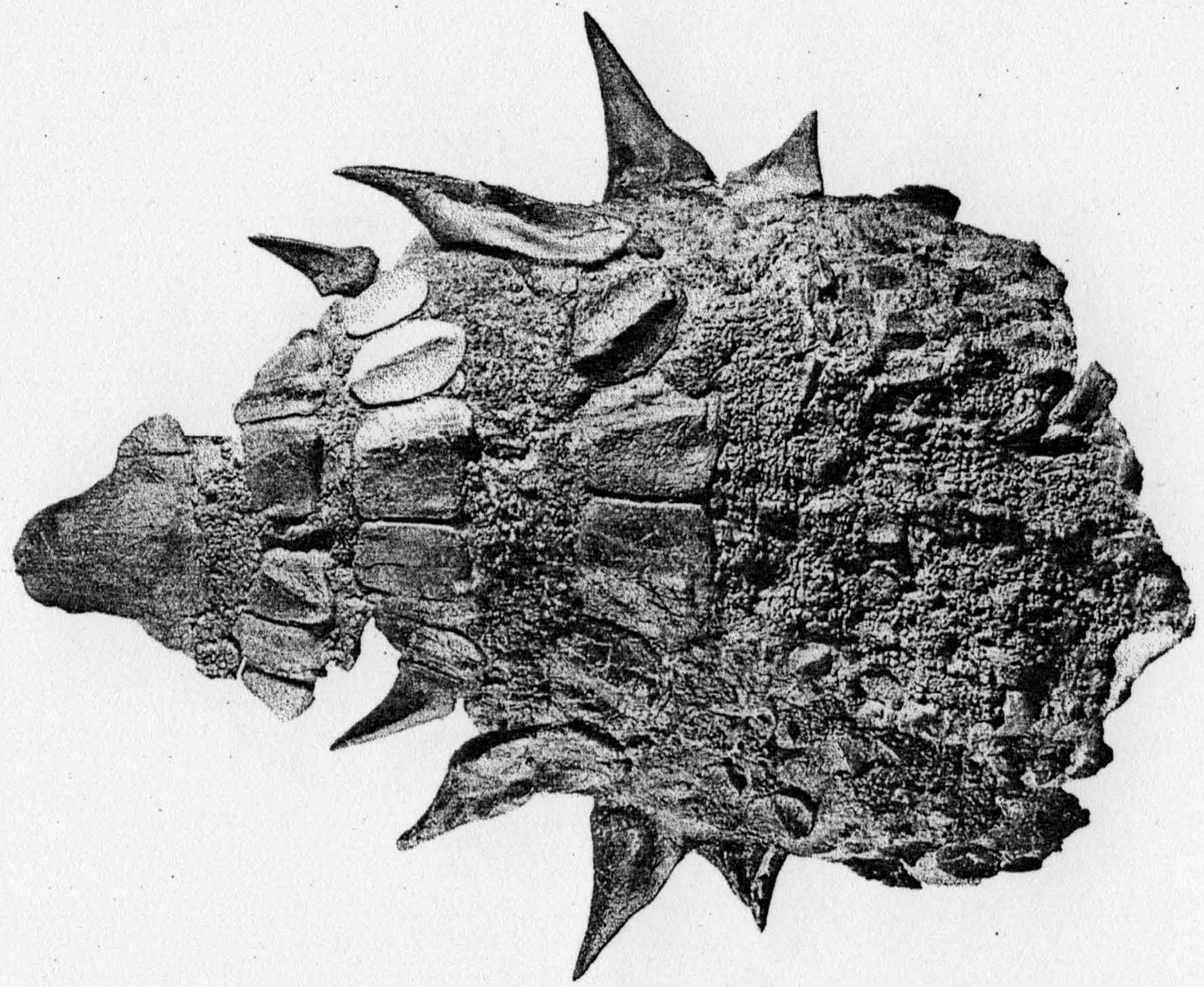|
Nodocephalosaurus
''Nodocephalosaurus'' (meaning "knob headed lizard") is a monospecific genus of ankylosaurid dinosaur from New Mexico that lived during the Late Cretaceous (late Campanian to early Maastrichtian stage, 73.49 to 73.04 Ma) in what is now the De-na-zin member of the Kirtland Formation. The type and only species, ''Nodocephalosaurus kirtlandensis'', is known only from a partial skull. It was named in 1999 by Robert M. Sullivan. ''Nodocephalosaurus'' has an estimated length of 4.5 metres (15 feet) and weight of 1.5 tonnes (3,306 lbs).Paul, G.S., 2016, ''The Princeton Field Guide to Dinosaurs 2nd Edition'', Princeton University Press It is closely related and shares similar cranial anatomy to '' Akainacephalus''. Discovery and naming In 1995, a partial skull of an ankylosaur was discovered weathering out of a grey mudstone a few hundred metres west of a new ''Parasaurolophus'' site in the De-na-zin member of the Kirtland Formation, New Mexico. Robert M. Sullivan and Thomas E. Willi ... [...More Info...] [...Related Items...] OR: [Wikipedia] [Google] [Baidu] |
Akainacephalus
''Akainacephalus'' (meaning "thorn head") is a monospecific genus of ankylosauridae, ankylosaurid dinosaur from southern Utah that lived during the Late Cretaceous (late Campanian, 76.26 Ma) in what is now the Horse Mountain Gryposaur Quarry of the Kaiparowits Formation. The type and only species, ''Akainacephalus johnsoni'', is known from the most complete ankylosaur specimen ever discovered from southern Laramidia, including a complete skull, tail club, a number of osteoderms, limb elements and part of its pelvis, among other remains. It was described in 2018 in paleontology, 2018 by Jelle P. Wiersma and Randall B. Irmis. It is closely related and shares similar cranial anatomy to ''Nodocephalosaurus''. Discovery and naming An almost complete skeleton of an ankylosauridae, ankylosaurid was excavated during the 2008, 2009, and 2010 field seasons from the Horse Mountain Gryposaur (HMG) Quarry in the Grand Staircase–Escalante National Monument, Kane County, Utah, Kane County, Ut ... [...More Info...] [...Related Items...] OR: [Wikipedia] [Google] [Baidu] |
Ziapelta
''Ziapelta'' is an extinct genus of ankylosaurid. Its fossils have been found in the Hunter Wash and De-na-zin members of the Kirtland Formation of Upper Cretaceous (Campanian) New Mexico. It was named in 2014, in a research paper led by ankylosaur researcher Victoria Arbour. There is a single species in the genus, ''Ziapelta sanjuanensis.'' The genus is named after the Zia sun symbol, a stylized sun with four groups of rays, having religious significance to the Zia people of New Mexico, and the iconic symbol on the state flag of New Mexico, and ''pelta'' (Latin), a small shield, in reference to the osteoderms found on all ankylosaurids. The specific name is in reference to San Juan County and the San Juan basin, where the fossils were found. Multiple specimens have been described to date, though the fossils are mostly from the front part of the animal. Its closest relative appears to be either ''Scolosaurus'' or ''Nodocephalosaurus'', depending on what cladistic model is used. ... [...More Info...] [...Related Items...] OR: [Wikipedia] [Google] [Baidu] |
Ankylosauridae
Ankylosauridae () is a family of armored dinosaurs within Ankylosauria, and is the sister group to Nodosauridae. The oldest known ankylosaurids date to around 122 million years ago and went extinct 66 million years ago during the Cretaceous–Paleogene extinction event. These animals were mainly herbivorous and were obligate quadrupeds, with leaf-shaped teeth and robust, scute-covered bodies. Ankylosaurids possess a distinctly domed and short snout, wedge-shaped osteoderms on their skull, scutes along their torso, and a tail club. Ankylosauridae is exclusively known from the Northern Hemisphere, with specimens found in North America, Europe, and Asia. The first discoveries within this family were of the genus ''Ankylosaurus'', by Peter Kaiser and Barnum Brown in Montana in 1906. Brown went on to name Ankylosauridae and the subfamily Ankylosaurinae in 1908. Anatomy Ankylosaurids are stout, solidly built, armoured dinosaurs. They possess accessory ossifications on cranial bones ... [...More Info...] [...Related Items...] OR: [Wikipedia] [Google] [Baidu] |
Kirtland Formation
The Kirtland Formation (originally the Kirtland Shale) is a Sedimentary rock, sedimentary geological formation. Description The Kirtland Formation is the product of alluvial muds and overbank sand deposits from the many channels draining the coastal plain that existed on the Cretaceous Interior Seaway, inland seashore of North America, in the late Cretaceous period. It overlies the Fruitland Formation. It is found in the San Juan Basin in the states of New Mexico and Colorado, in the United States of America. The base of the Kirtland Formation and its lowest sub-unit, the Hunter Wash member, has been dated to 75.02 ± 0.13 Ma. Together with the upper part of the underlying Fruitland Formation, this contains fossils representing the Hunter Wash local fauna. The border between the Hunter Wash member and overlying Farmington member dates to approximately 74 million years ago. The top of the Farmington member and bottom of the overlying De-na-zin member has been radiometrically da ... [...More Info...] [...Related Items...] OR: [Wikipedia] [Google] [Baidu] |
Ahshislepelta
''Ahshislepelta'' (meaning "Ah-shi-sle-pah Wash shield") is a monospecific genus of ankylosaur dinosaur from New Mexico that lived during the Late Cretaceous (late Campanian stage, 74.5 Ma) in what is now the Hunter Wash Member of the Kirtland Formation. The type and only species, ''Ahshislepelta minor'', is known only from an incomplete postcranial skeleton of a small subadult or adult individual. It was named in 2011 by Michael Burns and Robert M. Sullivan. Based on the size of the humerus, ''Ahshislepelta'' is larger than '' Pinacosaurus mephistocephalus'' but smaller than ''Talarurus'' and '' Pinacosaurus grangeri''. Discovery and naming In 2005, a partial postcranial skeleton of an ankylosaur was discovered from the Hunter Wash Member in the lower part of the Kirtland Formation, New Mexico at the Ah-shi-sle-pah Wilderness Study Area. The specimen was later collected over consecutive field seasons from 2005 to 2009 and was subsequently described in 2011 by Michael Burns and ... [...More Info...] [...Related Items...] OR: [Wikipedia] [Google] [Baidu] |
Parasaurolophus
''Parasaurolophus'' (; meaning "beside crested lizard" in reference to ''Saurolophus'') is a genus of hadrosaurid "duck-billed" dinosaur that lived in what is now western North America and possibly Asia during the Late Cretaceous period, about 76.9–73.5 million years ago. It was a large herbivore that could reach over long and weigh over , and were able to move as a biped and a quadruped. Three species are universally recognized: ''P. walkeri'' (the type species), ''P. tubicen'', and the short-crested ''P. cyrtocristatus''. Additionally, a fourth species, ''P. jiayinensis'', has been proposed, although it is more commonly placed in the separate genus '' Charonosaurus''. Remains are known from Alberta, New Mexico, and Utah, as well as possibly Heilongjiang if ''Charonosaurus'' is in fact part of the genus. The genus was first described in 1922 by William Parks from a skull and partial skeleton found in Alberta. ''Parasaurolophus'' was a hadrosaurid, p ... [...More Info...] [...Related Items...] OR: [Wikipedia] [Google] [Baidu] |
Ankylosauria
Ankylosauria is a group of herbivorous dinosaurs of the clade Ornithischia. It includes the great majority of dinosaurs with armor in the form of bony osteoderms, similar to turtles. Ankylosaurs were bulky quadrupeds, with short, powerful limbs. They are known to have first appeared in North Africa during the Middle Jurassic, and persisted until the end of the Late Cretaceous. The two main families of ankylosaurians, Nodosauridae and Ankylosauridae primarily originated from the Northern Hemisphere (North America, Europe and Asia), but the more basal Parankylosauria originated from southern Gondwana (South America, Australia and Antarctica) during the Cretaceous. Ankylosauria was first named by Henry Fairfield Osborn in 1923.Osborn, H. F. (1923). "Two Lower Cretaceous dinosaurs of Mongolia." ''American Museum Novitates'', 95: 1–1/ref> In the Linnaean classification system, the group is usually considered either a suborder or an infraorder. It is contained within the group ... [...More Info...] [...Related Items...] OR: [Wikipedia] [Google] [Baidu] |
Late Cretaceous
The Late Cretaceous (100.5–66 Ma) is the more recent of two epochs into which the Cretaceous Period is divided in the geologic time scale. Rock strata from this epoch form the Upper Cretaceous Series. The Cretaceous is named after ''creta'', the Latin word for the white limestone known as chalk. The chalk of northern France and the white cliffs of south-eastern England date from the Cretaceous Period. Climate During the Late Cretaceous, the climate was warmer than present, although throughout the period a cooling trend is evident. The tropics became restricted to equatorial regions and northern latitudes experienced markedly more seasonal climatic conditions. Geography Due to plate tectonics, the Americas were gradually moving westward, causing the Atlantic Ocean to expand. The Western Interior Seaway divided North America into eastern and western halves; Appalachia and Laramidia. India maintained a northward course towards Asia. In the Southern Hemisphere, Aus ... [...More Info...] [...Related Items...] OR: [Wikipedia] [Google] [Baidu] |
Gregory S
Gregory may refer to: People and fictional characters * Gregory (given name), including a list of people and fictional characters with the given name * Gregory (surname), a surname * Gregory (The Walking Dead), fictional character from the walking dead * Gregory (Five Nights at Freddy's), main protagonist of '' Five Nights at Freddy's: Security Breach'' ** Places Australia *Gregory, a town in the Northern Territory * Gregory, Queensland, a town in the Shire of Burke ** Electoral district of Gregory, Queensland, Australia * Gregory, Western Australia. United States * Gregory, South Dakota * Gregory, Tennessee * Gregory, Texas Outer space * Gregory (lunar crater) * Gregory (Venusian crater) Other uses * "Gregory" (''The Americans''), the third episode of the first season of the television series ''The Americans'' See also * Greg (other) * Greggory * Gregoire (other) * Gregor (other) * Gregores (other) * Gregorian (other) ... [...More Info...] [...Related Items...] OR: [Wikipedia] [Google] [Baidu] |
Tail Club
In zoology, a tail club is a bony mass at the end of the tail of some dinosaurs and of some mammals, most notably the Ankylosauridae, ankylosaurids and the glyptodonts, as well as meiolaniid turtles. It is thought that this was a form of defensive Armour (zoology), armour or weapon that was used to defend against predators, much in the same way as a thagomizer, possessed by stegosaurids, though at least in glyptodonts it is hypothesized it was used in Display (zoology), fighting for mating rights. Among dinosaurs, the club was present mainly in ankylosaurids, although Sauropoda, sauropods like ''Shunosaurus'' and ''Kotasaurus'' also possessed a tail club. Victoria Arbour has established that ankylosaurid tails could generate enough force to break bone during impacts. In a separate study, Arbour suggested tail clubs as well as large armoured herbivores as a whole evolve when animals are too large to hide and too small to avoid predation by size alone. Morphology In ankylosaurid di ... [...More Info...] [...Related Items...] OR: [Wikipedia] [Google] [Baidu] |








